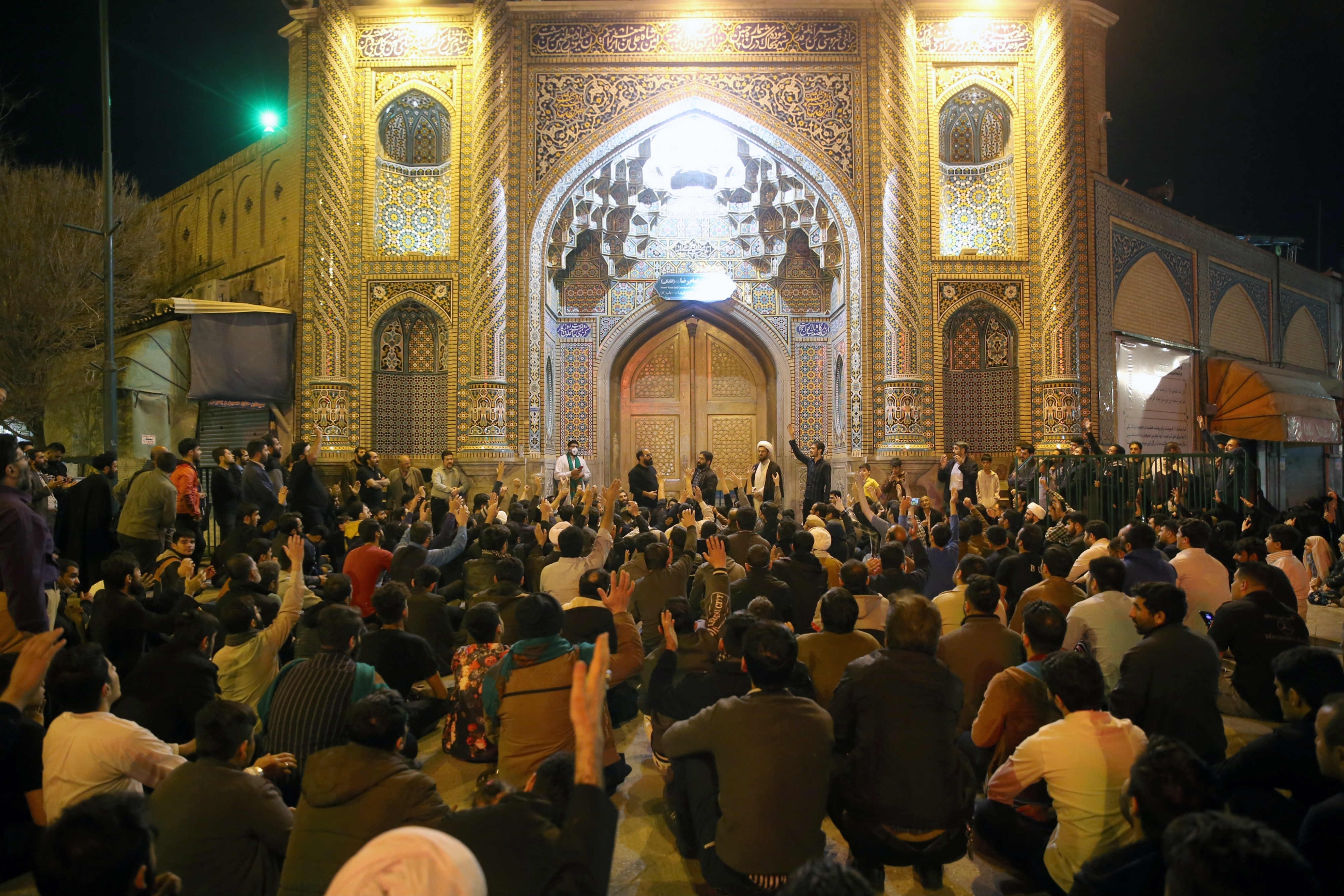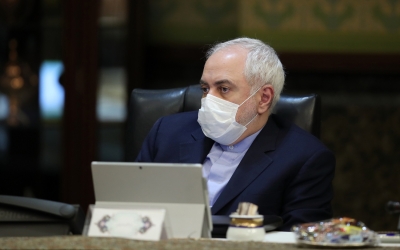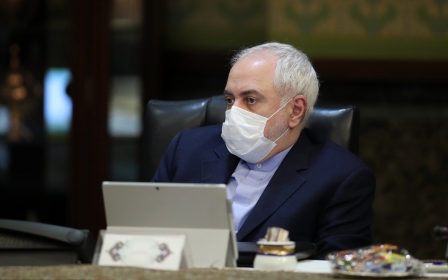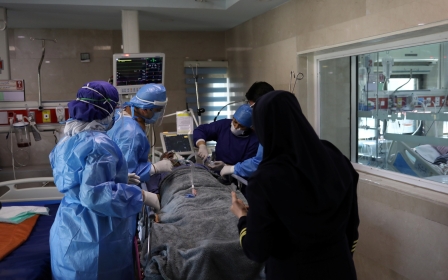Coronavirus: Hardliners fear 'radical' raids on Iran's closed shrines

On 16 March, a group of angry "radicals" raided the holy shrine of Fatima Masumeh in the Iranian city of Qom after the doors to the building had been locked in order to contain the spread of the coronavirus.
The act of breaking into the shrine in order to pray there shocked and outraged opinion, with many surprised to see the "radicals", who consider themselves as pious and loyal to Islamic values, disrespecting the shrine.
After Qom had been identified as the epicentre of the coronavirus in Iran, authorities had asked the the custodians of the shrine to close its doors. Initially they had resisted the pressure from the government.
However, following Supreme Leader Ayatollah Ali Khamenei's advice for everyone to follow the instructions of doctors in order to curb the spread of the disease, the shrine's custodian obeyed the health ministry and security officials’ demand.
Among other shrines ordered closed were those of Imam Reza in Mashhad and Shah Abdol-Azim in Tehran.
The "radicals" in Qom saw the move as a betrayal of their Islamic beliefs and called for an end to the restrictions.
Mobilising a group of their followers, they initially staged a sit-in in front of the shrine, then later broke the doors open in order to say prayers inside.
Even among Iranian hardliners, the act of defiance raised eyebrows. However, in many ways, they might have seen the move coming.
Islamic revolution gives birth to schism
After the Islamic revolution in 1979, religious leaders took over the country, but they were divided on various issues, including the enforcement of the sharia.
There were two main groups, known as the "right-wing" and the "left-wing".
The right-wing emphasised the strict enforcement of the sharia and jurisprudence (fiqh), while the left-wing called for the implementation of Ayatollah Ruhollah Khomeini's views and his interpretation of fiqh, which was based on "time and place conditions".
Khomeini believed that the state of affairs in a country could allow the jurists to alter some Islamic laws based on what was actually in the interest of that country.
In the 1980s, the two wings were involved in constant attacks against each other, leading the right-wing to be marginalised by Khomeini.
Taking repeated swipes at the group, Khomeini labelled them as “reactionary” and “American Islam”, leading to their further isolation.
Hadi Sorush, a cleric and researcher based in Qom, told Middle East Eye: “In retrospect, when you read the history of different religions, not only that of Islam, you see that there have been groups who were only concentrated on the [absolute adherence] of religious decrees, and didn’t allow others to reach a compromise."
Speaking on condition of anonymity, a cleric involved in the events of the 1980s, told MEE: "The issue was over flexibility and Imam Khomeini believed in flexibility, but the right-wing didn't."
Sensing an opportunity
In addition to the right-wing, Khomeini also labelled another group "reactionary", namely a number of clerics who had not joined the revolutionary movement ahead of the toppling of the Shah in 1979 and who held an inflexible view of Islam.
Ayatollah Mohammad-Taqi Mesbah-Yazdi, a prominent figure in the group, remained completely in seclusion during Khomeini's leadership.
Mesbah-Yazdi had once acted against Khomeini's orders before the revolution and Khamenei, the current supreme leader, was also upset with him over his lack of interest in helping the revolutionaries.
Sensing an opportunity, the right-wing group later started recruiting isolated clerics such as Mesbah-Yazdi to form a united front.
“The [alliance with the] reactionaries benefited the right-wing and they were cultivated by the hardliners to limit the power and courage of reformists,” the cleric involved in the events of the 1980s told MEE.
Nurturing the 'reactionaries'
Following the death of Khomeini in 1989, the right-wing was able to take over all branches of power, excluding the left-wing from politics and maintaining a monopoly of power over the country. This left the left-wingers isolated.
During this time, both the left-wing and right-wing moderated their strict religious views to some extent, but remained active under the new respective labels of "reformists" and "principalists" (hardliners).
In particular, the reformists' economic and political notions have changed drastically.
in the 1997 presidential election, against all the odds and following a consensus between the left-wing reformists and liberals, Mohammad Khatami won the race, delivering a heavy blow to the right-wing.
After his ascension to power, the right-wing and "radicals" sensed that Khatami was determined to bring about a major upheaval by giving more social and political freedoms to people, while simultaneously limiting the authority and power of the "establishment," which was still dominated by the right-wing.
To counter Khatami’s efforts, the right-wing played their winning card by cultivating and using the "reactionary" groups and clerics, including the Ansar Hezbollah group and Mesbah-Yazdi and his entourage.
These elements were constantly used to quash the reformists and were ultimately successful, causing Khatami to retreat from his plans.
Youthful leader
To this day, the “reactionary” groups and clerics are empowered and used by the right wing - with their views gradually getting closer and closer to each other - to silence left-wing reformists and moderates.
Iran's moderate President Hassan Rouhani and his foreign minister, Mohammad Javad Zarif, have repeatedly faced verbal threats and attacks from these elements.
The "reactionary" figures have been so strengthened that they are now in many important positions of power.
However, they are spinning out of the right-wing hardliners' control, as they appear to no longer recognise any boundaries.
The closure of the holy shrines in Qom, Mashhad and Tehran by Khamenei and the right-wing establishment exhibited a degree of flexibility that angered the "reactionary" groups and clerics.
Previously these elements had been trained and used to stage protests against Rouhani and his nuclear deal with the West, and labelled him as a betrayer - now they refused to accept the flexibility of the authorities that had cultivated them, resulting in their raiding of the shrines.
The "reactionary groups" have found a leader in the name of Rouhollah Dashti, a young cleric who had previously played a role in a hardliner-backed meeting in which Rouhani was threatened with death.
Dashti was later arrested but soon released, and the raiding of the shrines now seems to be a turning point and alarming sign for the hardliners, who thought they had the "reactionary" groups under control.
'The radical currents have always been dangerous'
Asked whether such groups posed an existential threat to the country and the right-wing dominated establishment, Hadi Sorush, a cleric and researcher based in Qom, told MEE: “Yes, one hundred percent.
"They also pose a threat to the religion. During the history of Islam, the radical currents have always been dangerous. It is also the same today."
While sensing the threat, the hardliners have been careful not to display their anxiety, attributing the raids on the shrines to the influence of "foreign agents".
Hossein Kanani-Moghaddam, a conservative politician, told MEE: "The attack was conducted by British Shias who seek to plant the seeds of disagreements and disputes."
However, he admitted that the “majority of people believe such behaviours are extreme-like and harm the religion".
Middle East Eye delivers independent and unrivalled coverage and analysis of the Middle East, North Africa and beyond. To learn more about republishing this content and the associated fees, please fill out this form. More about MEE can be found here.







